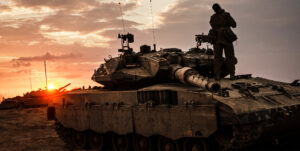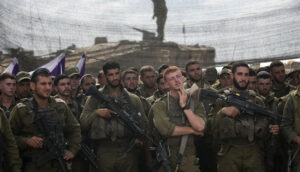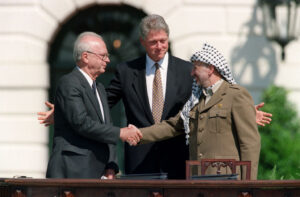As I look out over Lebanon from high up on Israel’s northern border, I see undulating hills dappled with hedgerows and green brush that glows golden in the winter sun. But this is far from an idyll. Lebanese Hezbollah have been firing into Israel since October 7. And it is from here that a regional, possibly global, war is most likely to start.
On the ground, with the ceasefire extended for another two days, relations between Israel and Hamas seem to be progressing. The temporary truce, however, is just a plaster on a gangrenous wound. If Hamas releases all of its hostages, then its leverage evaporates and it has nothing to deter Israel from its assault. If Israel ceases military operations now, then its promise that Hamas will never again be able to launch another attack is just empty rhetoric. Neither its traumatised population nor its desperate Prime Minister will allow that.
So, the war continues, with Israel completing its operation in northern Gaza and turning to the south. And along with its horrific cost, the chances of broader escalation will increase.
But the war with Hamas has already expanded. Hezbollah are firing from the north, Syrian groups from the northeast, the Houthis from Yemen in the south — and behind them all, Iran. Israel is now fighting a war on five fronts. But it’s in the north that the greatest threat lies.
“What we’ve been experiencing on the northern border are a few kinds of Hezbollah approaches,” says a source in the IDF’s Northern Command. “Number one: infiltration attempts on the border itself. Two: using anti-tank missiles to target Israeli soldiers, outposts, tanks and armoured vehicles. Three: using aerial vehicles [drones]. This did not really exist in [the Lebanon war of] 2006. The investment in aerial vehicles began in 2009.” Hezbollah, they tell me, is targeting a narrow strip just a few kilometres from the border, rather than cities further south such as Haifa. “From that we assess that the current decision of Hezbollah is not to escalate.”
But Hezbollah also needs to manage its optics. It cannot spend decades railing against the “Zionist Oppressor” and then do nothing when it is at war with the group’s supposed brethren in Hamas. “Hezbollah has activated a few Palestinians from the refugee camps in Lebanon,” I am told. “There is cooperation when interests converge when their interests converge, and Hezbollah is using Palestinians to fire anti-tank missiles at us.” Hassan Nasrallah, Hezbollah’s leader, seemingly confirmed these assessments when he congratulated Hamas on its attack last month, while stressing he had no idea it was coming. The signal was clear: we had nothing to do with this; beyond saving face, we don’t want to get involved.
But while 1914 is an overwrought analogy, here, with so many moving parts, escalation cannot be discounted. And beyond the trauma of October 7, many Israelis want action. The northern city of Qiryat Shemona is a mile from the Lebanese border. Today, after local authorities ordered civilians to leave in the face of daily rocket attacks, it is almost deserted. One man who hasn’t left is Moshe Peretz, 63, who owns a garage. He works with the IDF and local farmers and is, he tells me, an essential service provider. “I’ve been here 58 years and I’m used to this sort of stuff — sometimes Hezbollah would fire over 100 Katyusha rockets in one day. Back then we had to cram into small shelters.”
He continues, “if we pass this problem onto our children, then we haven’t achieved anything. We will have suffered 60 years for nothing. We can end it now – and we must.”
We drive up into the mountains, towards the border, through forest where IDF soldiers and tanks line the roads. At the summit, stands a thick metal barrier. It has been erected to protect us from fire from Lebanon. I cannot film it: it’s a new type of armour, I’m told. If I publish photos, the enemy will be able to analyse its thickness and adjust its fire accordingly.
The Hezbollah threat is incredibly potent. In 2019, US intelligence estimated the group had 150,000 projectiles in its arsenal, which includes Iranian Fateh-110 and Syrian M-600 satellite-guided missiles with a range of up to 186 miles, putting Tel Aviv in reach. Added to this are its anti-ship missiles, particularly the Iranian Noor and Russian Yakhont, as well as the 100,000 fighters Nasrallah claimed to have in 2021 — a figure which, while almost certainly inflated, is not entirely divorced from reality.
That said, Lebanon is also suffering its worst financial crisis in modern history. The last thing it needs is another war with Israel, especially since the one in 2006 brought such destruction to the country. And internally, Hezbollah is powerful right now — why throw it all away?
Meanwhile, the Houthis have launched several drone and missile attacks against Israel: a show of solidarity with the Palestinians and a display of strength to its domestic audience. Though not as powerful as Hezbollah, the group has Iranian Quds-351 cruise missiles, which it has used against Saudi oil fields and which have a reported range of 1,650km. It also has the Iranian Toufan ballistic missile that has a range of up to 1,950km (though unlike the Iranian original it is not precision guided). Finally the Houthis have a drone capability, notably the Samad UAV.
While their missiles are slow and inaccurate, they could theoretically overwhelm Israel’s Iron Dome if launched in conjunction with Hamas and Hezbollah. Before October 7, the most missiles Israel had faced in a day was 470 in May 2021. On October 7, it faced 5,200 in 20 minutes. Throw drones into the equation, and the picture becomes disconcerting. That said, the Houthis main fight is with Saudi Arabia. If it were to use all its weapons against Israel, the Saudis might sense opportunity, and move in for the kill.
In the end, though, the state that matters most is the one that stands behind Hamas, Hezbollah and the Houthis: Iran. Tehran bases its regional strategy on a doctrine of “Forward Defence” that, loosely speaking, means using regional non-state terror groups to fight its opponents abroad and retain stability at home.
Right now, Iran’s proxies are well-positioned around the borders of its two main regional rivals, Israel and Saudi Arabia — including a joint operation room with Hezbollah in the Golan Heights — which give it a degree of regional security it seems unwise to risk. After Israel and the United States bombed its Revolutionary Guard (IRGC) base in Syria in October, Iran has shifted many of its missile production facilities to Lebanon. Ultimately, these proxies deter direct attacks from Israel. If they are smashed, which will happen with escalation, the threat to Iran gets serious.
But Iran has other options. The IRGC has recently set up two new proxies in Syria: the Afghan Fatemiyoun and Pakistani Zainabiyoun groups whose stated goal is to destroy Israel. Iran can have them continue to attack the “Zionist Entity” at a limited level, while remaining largely unconcerned about retaliation as they are fundamentally expendable.
But in the end, while the Mullahs are happy for Hamas to hurt Israel, there is a limit to their support for it. Reuters reported that at a recent meeting in Tehran, Iranian Supreme Leader Ayatollah Ali Khamenei complained to Hamas boss Ismail Haniyeh that his country was not warned of the October 7 attacks and that it would not enter the war on their behalf.
For their part, the Israelis are immovable on the eradication of Hamas but also wary of a broader war. The IDF was clear: the end of Hamas serves everyone. Anything short of a decisive defeat, they say, would embolden every terror group in the Middle East.
This is partly why the UK and US have both deployed forces in the area. But, in truth, it is unintended escalation that is the greatest concern — especially when Hamas is still holding so many hostages. Standing in the mountains of northern Israel, I peer down at the roads below and imagine the domino effect a stray Katusha accidentally hitting an Israeli school bus would have.
One act begets another in a region where no one can back down in the face of their own, often oppressed populations. Dictatorships are better at sustaining wars — and casualties — than democracies, and worse at avoiding them. From al-Houthi to Nasrallah to Khamenei, they continue to fight because policy and rhetoric cannot allow otherwise.
On 3 August, 1914, as the United Kingdom entered World War I, the British foreign secretary, Sir Edward Grey, remarked darkly that “the lamps are going out all over Europe, we shall not see them lit again in our lifetime”. Today in the Middle East, a return to 1914 seems, if not yet imminent, then no longer beyond the realms of possibility either.
Disclaimer
Some of the posts we share are controversial and we do not necessarily agree with them in the whole extend. Sometimes we agree with the content or part of it but we do not agree with the narration or language. Nevertheless we find them somehow interesting, valuable and/or informative or we share them, because we strongly believe in freedom of speech, free press and journalism. We strongly encourage you to have a critical approach to all the content, do your own research and analysis to build your own opinion.
We would be glad to have your feedback.
Source: UnHerd Read the original article here: https://unherd.com/




